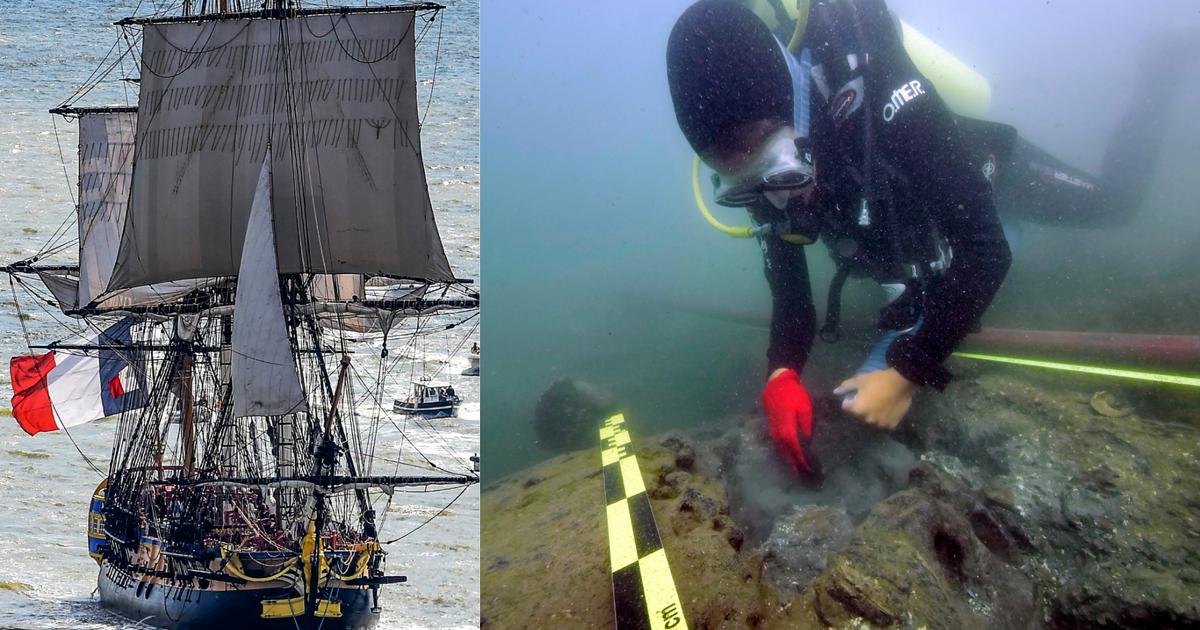The Caribbean depths of Antigua's Tank Bay aren't just home to speckled seahorses and butterflyfish.
They also envelop a ship, whose robust carcass has been resting for more than two centuries in the mud of this tourist cove in the Lesser Antilles.
The presence of an underwater structure was identified in 2013, during a hydrographic survey carried out on the south coast of the island.
Troubled waters once protected the site's secrecy.
Ten years later, archaeologists finally see it clearly: it was the wreck of the
Lyon
, a former ship of the French East India Company, sunk in 1778.
The ship, which rests approximately five meters deep, in the UNESCO-listed port of English Harbour, is believed to be the Company's only known wreck to date.
“It's a huge vessel, 45 meters long and fairly well preserved, especially on the entire starboard side of the hull.
The remains are in an area quite close to the mangroves, which means that the salinity of the water has kept the xylophagous worms
away ,
”
says archaeologist Jean-Sébastien Guibert, lecturer at the Martinique campus of the University of the West Indies.
Read alsoPyramid of Cheops: extraordinary discovery of a corridor, hidden for 4500 years
In collaboration with the National Parks of Antigua, the American University of East Carolina and the Association Archeologie Petites Antilles, the researcher excavated the wreckage last fall, a year after a first tighter campaign which had made it possible to square the site.
The team made up of 26 specialists, including ten American students, already had a good clue about the identity of the ship which is still at the bottom of the port of Antigua and Barbuda.
A map.
Not a treasure map, in vellum battered and seasoned by adventure, but a military map, expertly drawn, in 1783, in an office of the British Admiralty.
An O – rather than an X – indicated, in a corner of the cove,
"
Lyon
, French ship of 40 guns"
.
The wreckage had to be reported to local navigators.
A few centuries later, it enchants historians.
From the spice trade to the English blockade
Anxious to put a story on the name of this wreck, but also to verify that it is indeed the
Lyon
, the researchers comb through the archives to find a trace of the ship.
The vessel is said to have been built in Lorient in 1762 for the French East India Company.
Initially armed with 22 guns, she was launched under the name of
Beaumont
- a model of the ship is presented at the Dieppe museum.
His first expeditions lead him to Reunion, China, Bengal.
In 1774, the
Beaumont
was bought by two slave shipowners from Saint-Malo, renamed
Lyon
then ceded again in 1777, this time to a certain Jacques-Donatien Le Ray de Chaumont.
Steward of the Invalides, the man is more focused on powder than on spices.
Above all, he sympathized with the cause of the Thirteen Colonies and then with the revolutionaries of the New World, at the outbreak of the American War of Independence.
Study of the rudder of the
Lyon
.
The French wreck lies 4 to 5 meters deep, at a place called Tank Bay, in the port of British Harbor (Antigua and Barbuda), a historic site listed by Unesco.
Claude Michaud, AAPA, University of the West Indies
Under this new patronage, the former ship of the French East India Company is armed with 40 guns and heads for the American coasts to break through the blockade imposed by England on its renegade colonies.
If it sails alongside the squadrons of Louis XVI, the
Lyon
is not ceded to the Royal Navy.
Its captain at the time, Jean Michel, was even tempted to become a privateer.
“His mission was off the beaten track and straddled trade and military activity.
It would seem that on his return, he even considered receiving a letter of marque
, ”says Jean-Sébastien Guibert.
Read alsoThe Hermione, the famous “Frigate of Lights” in the middle of a storm
The
Lyon
was however intercepted on November 3, 1778, when it was sailing - laden with tobacco - towards the metropolis.
A Royal Navy-flagged frigate, HMS
Maidstone
, looms on the horizon.
A duel begins off Cape Henry and the strategic bay of Chesapeake, where the fleet of the Count de Grasse will inflict a decisive setback on the English forces, three years later.
The
Lyons
and the
Maidstone
maneuver, exchange volleys of guns.
Smoke and gunpowder sing for nearly fourteen hours until this ballet on the high seas ends with the surrender of the French ship.
Bloodless, the
Maidstone
escorts his catch and what remains of his crew back to Antigua.
The two ships reach the port of English Harbour, where there was a naval base at the time.
A ship from beyond the grave
“The two ships were in very bad shape after their engagement,
notes Jean-Sébastien Guibert.
The English captain thus had to make a stopover in the West Indies, for lack of certainty of braving the Atlantic and reaching London in one piece.
The French ship is stripped to the bone, meticulously dismembered and then scuttled in a corner of the cove.
During their underwater surveys, archaeologists indeed noticed traces of this dissection operation before reuse.
All the cannons have disappeared;
and the furniture collected by a sediment vacuum cleaner is reduced to a few shards of ceramics, a flint, a few fragments of smoking pipes or even a musket ball.
Read alsoEaster Island: a new statue discovered in a dry lagoon
Despite everything, several clues allow the researchers to accredit their identification of the wreckage.
“These vestiges are prior to the 1780s because the hull is not reinforced by a copper lining,
advances Jean-Sébastien Guibert.
The typology of the objects collected in our three surveys also indicates that we are on a wreck from the second half of the 18th century
”.
The examination by dendrochronology of the wooden remains taken from the site should make it possible to refine, in the coming months, the dating of the wreck and to remove the last doubts about it.
In the meantime, the researchers are delighted to have found so many clues that support their hypothesis.
“This kind of quite exceptional wreck should make it possible to document the French naval construction of the time.
It is widely known through theoretical texts and models, but authentic specimens remain extremely rare.
remarks Jean-Sébastien Guibert.
Funded in particular by the Ministry for Europe and Foreign Affairs and by the Department of Memory, Culture and Archives of the Ministry for the Armed Forces, this research should continue in the coming years.














